Menus
- How good is the 1994 icon really?
- Chassis much faster than the engine
- Through the fast slalom
- With the brake measurements to the limit
- How does it look on the country road?
- Conclusion
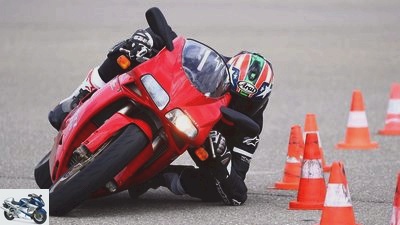
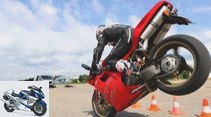
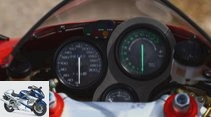
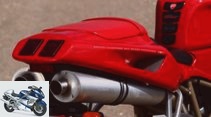
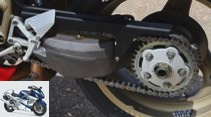
22nd photos
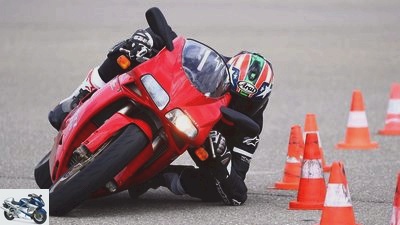
1/22
When the Ducati 916 came onto the market in 1994, the top test had not yet been carried out, hence the daring idea of chasing it through the courses on its 25th birthday of all things.
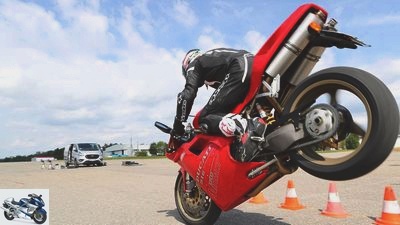
2/22
The 916 takes 40.6 meters from 100 km / h to a standstill.

3/22
The speedometer is still driven mechanically.
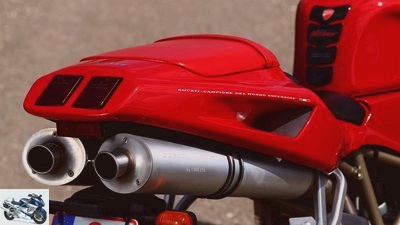
4/22
Elevated silencers promote lean angle and aerodynamics, but not necessarily handiness.
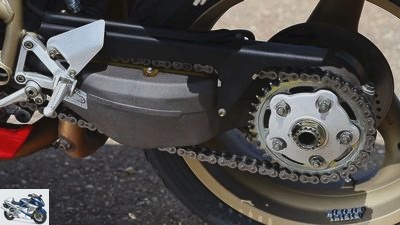
5/22
The single-sided swing arm with eccentric axle support makes it easier to remove wheels and adjust the chain.
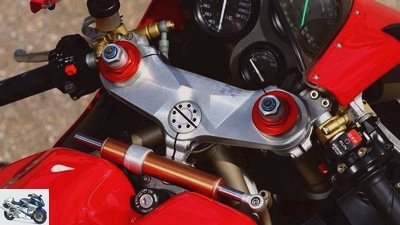
6/22
Such an arrangement of the steering damper had no other motorcycle before the 916.
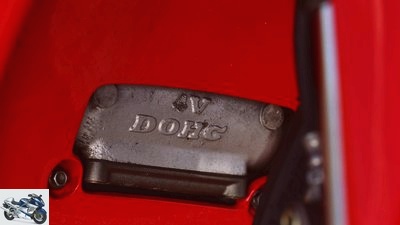
7/22
The recess in the front mask indicates the Desmoquattro. With the more compact Testastretta engines it was closed.
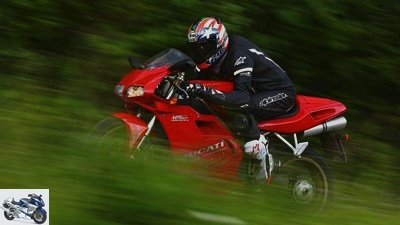
8/22
To some extent it can be seen that the rear side of the tank rises a little too steeply.
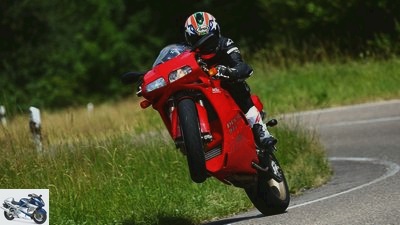
fact
9/22
For a base price of 28,890 marks there was 109 hp in 1995.
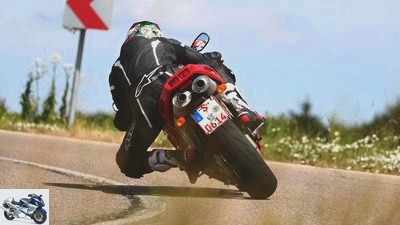
10/22
The processing quality of the 916 is its big plus in the everyday chapter. Carefully laid electrics, high-quality plug connections and precisely fitting trim parts provide a good example of this.
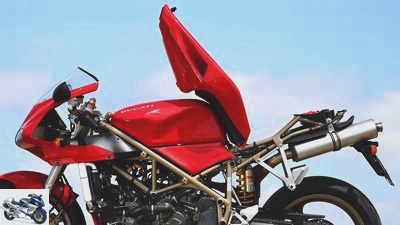
11/22
Thanks to the well-thought-out construction of the tank, seat and paneling, an experienced mechanic can quickly undress the 916. But screwing the engine turns out to be quite complicated.
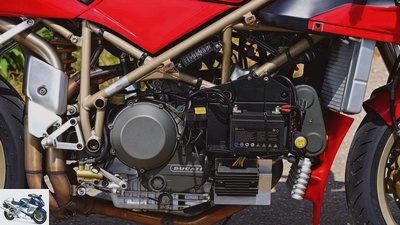
12/22
The right case cover is a Pantah legacy from the late 1970s. In the 916 it is covered by all kinds of electrical equipment; therefore, the battery holder must be removed when filling in oil.
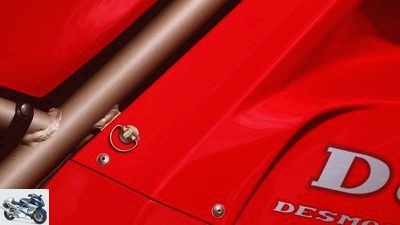
13/22
Quick-release fasteners: Not only the quick-release fasteners, but also their ergonomic shape show how carefully Massimo Tamburini and his employees have considered even the smallest details.
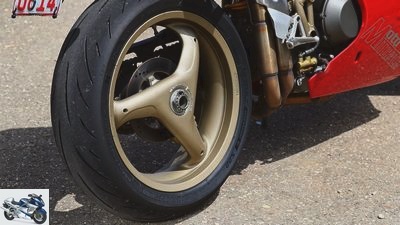
14/22
Heavy wheels: The rear wheel of the 916 weighs around six kilograms, and it doesn’t even have wheel bearings. The wider six-inch model of a Fireblade SC59 is 900 grams lighter with wheel bearings.
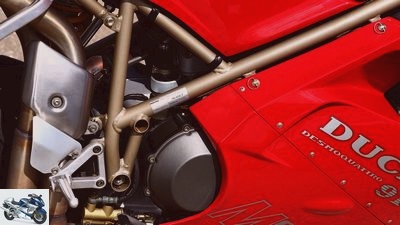
15/22
Swing arm bearing: On the 888, the swing arm was only mounted in the engine, but it was clear that a stiffer mount would be needed in racing. Therefore the lateral pipe triangles.
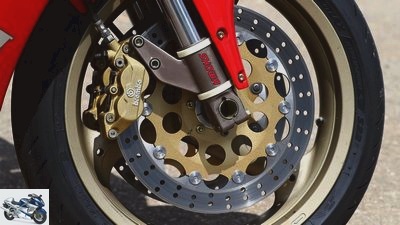
16/22
Brake discs: The original brake discs of the 916 Strada were thin, but quite heavy because of the steel adapter. Quite a few Ducatisti have retrofitted stronger and lighter windows.
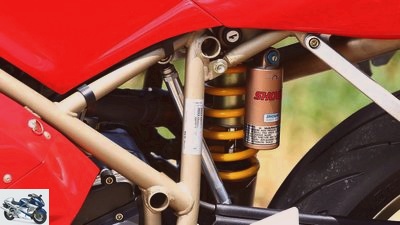
17/22
Suspension strut: The Showa damper did its job just as well as the fork from the same company. And certainly no worse than the Ohlins parts of the immensely expensive 916 SP.
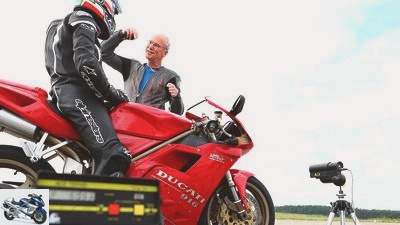
18/22
What we didn’t do: set the steering head steeper. For road use, the eccentric insert that accommodates the shoulder ball bearings is permanently fixed with a shear bolt.
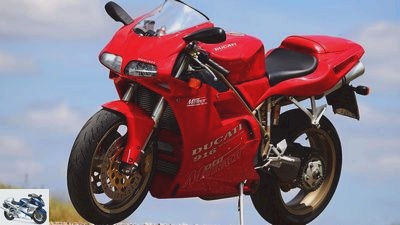
19/22
At first none of us wanted to drive it. It is just too beautiful, the new, well-kept loan from Moto Mittrach in Zweibrucken.
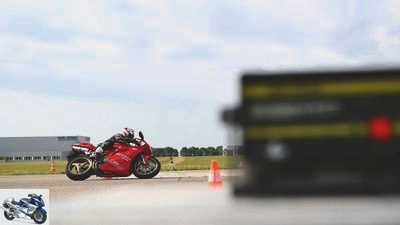
20/22
In the slow slalom, the rather sluggish high-speed handling is not noticeable. Here the 916 is too big, circles the pylons with millimeter precision and thus reaches a striking speed.
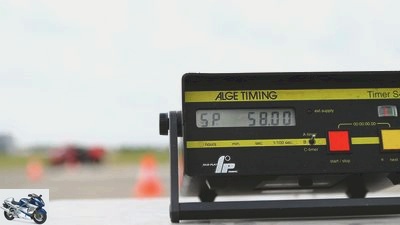
fact
21/22
The 916 managed 58.0 km / h and more in the slow Salom.
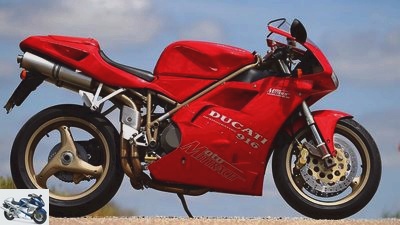
22/22
Out of a maximum of 1000 points in the overall evaluation, she achieved 540 points and thus received a value for money rating of 4.0.
Ducati 916 Strada Biposto in the test
How good is the 1994 icon really?
When the Ducati 916 came onto the market in 1994, the top test had not yet existed, hence the daring idea of chasing it through the courses on its 25th birthday of all places. How does it compare to current athletes?
At first none of us wanted to drive it. It is just too beautiful, the new, well-kept loan from Moto Mittrach in Zweibrucken. “It looks like it has just rolled off the line and has not even 2,000 kilometers on the clock, we should photograph it while we are standing and otherwise not touch it.” That is the unanimous opinion of all those who devoutly and respectfully around them 916 circled. It was only gradually that it was realized that this motorcycle was built to be driven.
Buy complete article
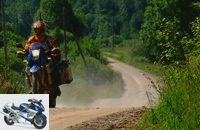
Top test Ducati 916 Strada Biposto
Report on the inclined position
A mixture of respect and skepticism
Top tester Karsten Schwers took on the task of the photo driver with a mixture of respect and skepticism. Spoiled by the latest crowns of super sports creation, he began his mission with a reserved “Let’s see.” And returned deeply impressed. “The precision with which it steers in, the feedback from the front tire and the safety in deep lean angles are still top notch. Today’s motorcycles can’t do that better. “
For a base price of 28,890 marks there was 109 hp in 1995.
Karsten certified the Desmoquattro-V2 as having “beautiful country road characteristics”, even though it lacks performance by today’s standards. To today’s standards it should be added that the Test-916 Strada Biposto plays in the league of current Monster 821, Hypermotard 939, SuperSport and Multistrada 950, with 109 to 113 hp. It is an interesting idea to combine a 916 chassis with one of these Testastretta V2s, but such a combination would not solve the core problem of the 916 Strada: the chassis and ergonomics predestine it for the race track, for which it no longer has enough power.
Chassis much faster than the engine
Which is not to say that it would still not be good for impressive lap times if an experienced driver did his rounds alone with it. This is seldom the case, however, and so 916 drivers experience irritating “rhythm disturbances” during race training courses in which the group is divided according to the lap times of the participants: where they are fast, many others are slower, where they are not due to limited engine power faster, these others pull by again. A modern, standard 600 is sufficient for this. Anyone who wants to purchase a 916 today or even just analyzes the measured values from the top test course should know about this dichotomy: the chassis is much faster than the engine. How fast is only really clear when you take into account the fact that the lap times in both slalom courses are measured from the standing start, but we did not expect the red beauty to make very sharp starting maneuvers. One or the other tenth that you lack in the time you spend on the reference motorcycle 848 Evo is at the expense of careful use of the clutch. And even in the fast slalom it achieves excellent values, although its only suspension problem is clearly evident there. It is a stubbornness of straight-line stability that increases with increasing speed, which makes the 916 pretty hip-stiff at around 100 km / h.
The 916 takes 40.6 meters from 100 km / h to a standstill.
The reason for this lies not in the chassis geometry, but – as experience shows – primarily in the weight and gyroscopic torque of the three-spoke cast wheels from Brembo. For comparison: the front wheel of a standard Fireblade weighs 3.7 kilograms without tires and brake discs, that of the 916 weighs 5.3 kilograms with the same rim dimensions. And the standard brake discs are quite thin, but because of the steel adapter they are around 400 grams heavier than the thicker gray cast iron discs of the SP models with anodized aluminum adapters – I don’t exactly remember the value determined many years ago. The heavy steel rear frame of the Biposto models also contributes to the sluggish high-speed handling. It packs several kilograms more to the rear than the aluminum rear frame of the SP models in combination with the lighter solo bench seat.
Through the fast slalom
That’s why you don’t wag through the fast slalom – this expression suggests a looseness that does not come about – but yank the handlebars violently to balance the 916 from one lean angle to the next. In doing so, one becomes aware again why their ergonomics have always been felt to be strenuous. The height difference between the driver’s seat and the handlebar grips is not extreme, but on the one hand the handlebars are designed to be narrow, on the other hand the tank looks very long because of its steeply rising rear side. So it is not easy for the driver to hold the weight of his upper body. Either he is supported stiffly on the handlebars, or the muscles of the arms, stomach, shoulders and neck are heavily used. This is particularly noticeable when you are not in racing mode, but glide quickly and peacefully on the country road.
The speedometer is still driven mechanically.
Of course, nothing of this can be felt in the circular path. The seating position is ideal for hanging-off in a sloping position, and so the driver and machine are in great shape there. The new Bridgestone S 22 contributed the grip to a performance that made the viewer marvel at it. The 916 circulated evenly diagonally around the forest of pylons – it almost seemed as if it was lying relaxed on the lower part of its narrow-cut fairing. The lap times were impressive, the speeds through the light barrier even more. And because a channel is crossed twice per round in a fully inclined position, the fork and shock absorber were able to demonstrate their excellent responsiveness. Mind you, these are the Showa suspension elements of the Strada version. They confirmed the impression I once made with my own 916, that they are at least equal to the Ohlins parts of the SP models. Tightly damped, no question about it, and therefore not as comfortable as the long-stroke suspension of a travel enduro or the well-tuned semi-active chassis of a modern super sports car, but still fully up to date in terms of the quality of the mechanics and the tuning.
With the brake measurements to the limit
The last top test discipline was brake measurement. The first years of the 916 were downright notorious for their brakes. The brake discs already mentioned are partly responsible for this, but it is primarily the brake pump. With increasing travel of the brake lever, its toggle presses on the hydraulic piston at an increasingly unfavorable angle, so that the unavoidable side effects of strong deceleration, such as widening pliers, heated brake fluid and rubber lines, result in a soft pressure point. One should definitely not afford to neglect the venting of the hydraulics. On this point, thanks to the careful work of the Mittrach mechanics, the test machine was beyond any doubt, but it also struggled with problems. The friction pairing appeared blunt, but gained in bite up to a certain degree of heating, the braking effect was difficult to dose.
The processing quality of the 916 is its big plus in the everyday chapter.
When Karsten gradually approached the limit with the brake measurements, he succeeded in a very good attempt, which is documented here. In the next few attempts, however, the braking distance increased dramatically – with the pressure point remaining stable. So it wasn’t the brake fluid that boiled and caused the fading, apparently the other brake components overheated. The thin steel disks can absorb little heat and, due to the poor thermal conductivity of their steel adapters, also emit less to the wheel hub. The pads became so hot that they hardly had any effect. After a ten-minute cooling-off, everything was almost back to normal.
How does it look on the country road?
As readily as the 916 had thrown itself into the course, it seemed to have been relieved after this experience when we invited it to a brisk lap of the country road that afternoon. In a direct comparison with her instructor, a Triumph Street Triple RS, her special characteristics emerged again clearly. In tightly looped, pass-like descents into the Danube Valley, it was necessary to brake in good time before the curves and to change lean angles with committed physical effort, while the light-footed Streety literally danced through the alternating curves with her precisely adjustable brake.
The legendary Ducati achieved 540 points out of a maximum of 1000 points in the overall ranking.
In individual bends – also turns, but especially in wider radii – the respective Street Triple driver saw the beautiful fairing front of the 916 but very large in the rearview mirror. It’s a lot of fun to see how precisely it follows the anticipated line, even when it leads over bumps, and how it keeps cornering speeds high. The strong center of the Desmoquattro also comes into its own on the country road. If you drive it up to the rated speed under load, it takes on a hard, dry tone and begins to vibrate. You don’t want to expect him to shake himself up very often and therefore prefer to shift quickly and precisely into the next higher gear. According to my statistically unproven observation, fewer and fewer motorcyclists take up the challenge of sporty country road driving on a super sports car. But for this dwindling group, the 916 is still an almost ideal motorcycle. But please, please don’t put a superbike handlebar on it. She didn’t deserve that.
Conclusion
What there is to criticize about the Ducati 916 mainly concerns the periphery. Lighter wheels, lighter rear, better brakes – we would have loved it even more. Ducati gradually incorporated all of these improvements into the series. With the Testastretta, the engines also gained enormous power and smoothness. In this birthday test, the basic 916 was reserved to demonstrate the high level of the basic concept. She succeeded.
Related articles
-
Comparison test Ducati 996 S, Honda CBR 900 RR, Triumph Daytona 955i
PhotoGargolov comparison test Ducati 996 S, Honda CBR 900 RR, Triumph Daytona 955i Strategy games Four wins? Or would you rather be quick with three? …
-
Photos: Kunstle Test Ducati ST3 S ABS The one which Only the ST3 with a water-cooled three-valve engine and, very recently, G-Kat remained of Ducati’s…
-
Comparison test BMW K 1200 RS against Ducati 944 ST2 against Honda VFR
Comparison test BMW K 1200 RS against Ducati 944 ST2 against Honda VFR Three just in case Three motorcycles, three different concepts, one requirement:…
-
Top test Ducati Sportclassic GT 1000
Gargolov Top test Ducati Sportclassic GT 1000 Power flower Top test Ducati Sportclassic GT 1000 In places they took it very seriously, for example with…
-
Gargolov 10 pictures Ducati 1/10 Ducati Diavel Carbon: The Italians officially presented their Power Cruiser at the Eicma. The Testastretta 11 ° engine …
-
Ducati Monster 1200 S in the PS performance test
fact 18 pictures fact 1/18 Even if the red iron has almost nothing to do with a racer. There are a few things that are essential for the Monster 1200 S in …
-
Comparison test: Ducati 1198 S against Ducati Multistrada 1200 S
Jahn comparison test: Ducati 1198 S against Ducati Multistrada 1200 S Ducati 1198 S against Ducati Multistrada 1200 S Content of One brand, one engine, two …
-
Top test Ducati Monster 620 i.e. S.
Gargolov Top test Ducati Monster 620 i.e. S. Promotion of young talent Although so many have found the baby monster to be really cuddly in the past,…
-
Ducati 959 Panigale and MV Agusta F3 800 RC in comparison test
28 pictures 1/28 The two beautiful Italian racers Ducati 959 Panigale and MV Agusta F3 800 RC in a comparison test ….
-
Comparison test BMW S 1000 RR, Ducati 1299 Panigale S and Yamaha YZF-R1
fact 46 pictures fact 1/46 Yamaha YZF-R1. fact 2/46 BMW S 1000 RR. fact 3/46 The swing arm takes the wheel axle very far back – good for the …